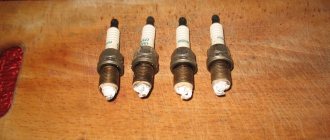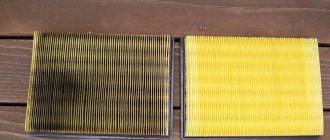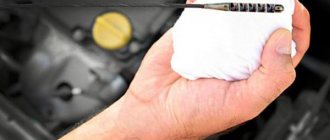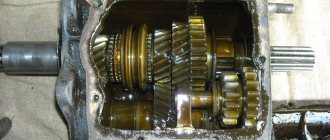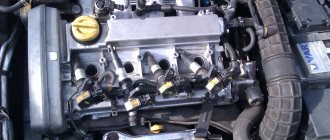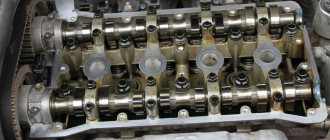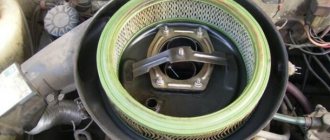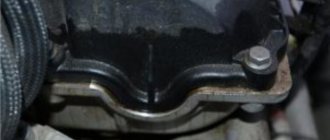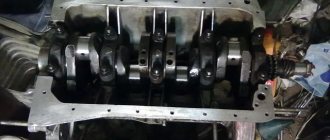As you know, an internal combustion engine consists of a large number of loaded parts and assemblies. At the same time, for normal operation of mating surfaces (friction pairs), it is necessary to apply lubricant to such surfaces. Motor oil in the engine serves to protect, lubricate, cool, and remove wear debris.
Malfunctions lead to the fact that oil begins to be intensively consumed, the operation of the ignition system is disrupted (spark plugs in oil), the combustion chamber becomes contaminated with oil, the engine cokes, etc. Next we will talk about why the lubricant ends up in the engine cylinder and the spark plugs are filled with oil, as well as what could be the cause of such a malfunction.
Read in this article
Engine oil enters the combustion chamber: main reasons
So, the driver may find that the spark plugs are in oil, the engine emits bluish smoke, increased oil consumption, and the power unit starts up less well, may stall, engine power is somewhat lost, etc.
It is not surprising that lubrication in the combustion chamber negatively affects the operation of the internal combustion engine. Otherwise, engine oil burnout (the lubricating fluid in the engine cylinder burns at the moment when the fuel-air mixture is burned in the cylinder) not only requires constant monitoring of the level and topping up of lubricating fluid, but also gradually disables the engine.
It is quite obvious that this problem needs to be solved as quickly as possible in order to avoid more serious consequences. Now let's look at why oil gets into the combustion chamber.
As for the reasons, experts highlight the following in the list of main ones:
- there are problems with the valve guides or valve seals;
- the valves themselves are faulty;
- piston rings are stuck or worn;
- the engine has been overfilled with engine oil;
- there are problems with the ventilation of the boat;
Next, we will consider these faults in order. Typically, wear on the inner surface of valve guides results in severe play between the valve stem and the valve guide. As a result, oil from the cylinder head enters the combustion chamber and oils the spark plugs.
A less common problem area is the valve guide, which comes out of the cylinder head body. Typically, this situation arises if the guides have already been changed previously, but the standard ones were not repair enlarged ones, but standard ones.
- If we talk about valve seals, these parts are made of rubber. Over time, the oil seal hardens, loses elasticity and begins to leak oil into the cylinders. Overheating of the internal combustion engine can also quickly damage valve seals.
The list of symptoms indicating problems with valve seals includes the presence of oil on the spark plug threads, as well as the appearance of a blue oily exhaust when the engine is cold. In this case, after warming up the internal combustion engine, the smoke intensity decreases or completely disappears.
In addition to the loss of elasticity of the oil seals, it is quite possible that the compression spring has stretched, the spring may jump off the oil seal body, etc. It also happens that the oil seal “comes off” from the guide sleeve. If the bushing is worn, the valve begins to operate in such a way that the pressure is on only one side. As a result, the lip of the oil seal bends, thereby allowing oil to enter the combustion chamber.
We also note that the valves themselves also wear out. If we talk about oil in the cylinders, then the problem is related to the valve stem. Wear of the stem results in an increased gap between the valve guide and the valve stem. In this case, the oil “drains” into the cylinder through leaks. To effectively solve the problem, it is necessary to replace the valves, and also, in many cases, the valve guides.
- As for cylinders and pistons, in this case, during the movement of the piston, friction occurs between the cylinder wall and the piston rings. Piston rings are installed on the piston and are necessary to seal the gaps between the piston and the cylinder walls.
In order to achieve lubrication and at the same time avoid oil from entering the combustion chamber, a so-called oil scraper ring is placed on the piston, which “removes” lubricant from the cylinder wall as the piston moves. If the rings are worn out or there are defects in the cylinder surface, then the engine oil is literally drawn into the combustion chamber.
Signs of ring problems include a buildup of engine oil on the spark plug threads as well as on the insulator. To more accurately determine the malfunction, it is recommended to measure the compression in the engine cylinders. If the compression is low, one possible solution would be to replace the piston rings. The pistons themselves are also changed quite often, since the partitions under the rings on them may well crack.
- A high oil level in the engine occurs both after an overflow of lubricant, and if antifreeze/antifreeze or a large amount of fuel gets into the oil system. If the issue is a normal excess of the level, then the excess oil from the engine needs to be pumped out.
- The crankcase ventilation system normally neutralizes the accumulation of crankcase gases and normalizes the pressure in the crankcase. If the ventilation does not work properly, the pressure increases, which causes oil to enter the combustion chamber.
As a result, the piston rings cannot “remove” excess oil from the cylinder walls, lubricant enters the combustion chamber, the spark plugs become oily, etc.
What's the result?
As you can see, oil in the engine cylinders can appear for various reasons. In all cases, an increase in lubricant consumption is observed, bluish smoke appears from the exhaust pipe, and the presence of lubricant on the spark plugs is also noted.
It is important to understand that there should not be excess oil in the combustion chamber. Otherwise, the engine will be subject to increased wear, the combustion chamber will become dirty, valve seats and discs will suffer, as well as CPG elements. For this reason, it is necessary to promptly identify and eliminate the cause of the appearance of oil in the engine cylinder.
Why spark plugs flood on injection and carburetor engines: the main reasons for wet spark plugs. How to dry spark plugs and start the engine, tips.
The main reasons for engine oil getting into spark plug wells. What should a driver do if oil flows into the spark plug well, how to carry out repairs with his own hands.
What does the color of carbon deposits on a spark plug indicate, and why does carbon deposits of one color or another form? How to clean spark plugs from carbon deposits with your own hands, tips.
Why oil leaks from the engine breather: signs and main causes of such a malfunction. How to understand why oil is flowing through the breather, troubleshooting.
How to check engine performance using spark plugs. The main signs of engine malfunctions: the appearance of black, gray, red and white carbon deposits on the spark plugs.
Why oil leaks from a car engine: causes and signs of a motor oil leak. What should the driver do and how to find the place where the oil is leaking from the internal combustion engine.
Oily consistency
A black deposit of an oily consistency, which is located on the surface of the thread and on the surface of the electrode, may indicate an excess of oily solution inside the VSC. Another sign is blue smoke from the exhaust pipe when starting the engine. There may be several reasons:
- the caps on the oil removal valve are out of order and worn out;
- it's time to change the rings on the pistons;
- The inner valve guide type bushings are worn out.
The main problem is a malfunction in the cylinder-piston group; parts need to be replaced.
Spark plug faults
Faulty spark plugs almost always lead to various kinds of problems in the operation of the car engine. For example, unstable idling (the engine “troits”, the speed fluctuates), dips, jerking, twitching, loss of power and throttle response, difficult starting (both cold and hot) are often a consequence of the use of defective spark plugs.
First of all, we check for the presence of a spark at the electrodes of the spark plugs. Then you need to unscrew them from the engine and carefully inspect them. At the same time, this procedure will be a diagnostic of the operation of your car’s engine, since their appearance is an indicator of what is happening inside it.
Below is a list of the main, ubiquitous spark plug faults.
Cracks on the insulator
Visually visible cracks and chips on the spark plug insulator are a reason to immediately replace it. They can appear either on the top of the spark plug insulator or on the heat cone around the central electrode. The reasons for their appearance are natural wear and tear as a result of long-term use, poor quality of the insulator material, non-compliance with the technology of its manufacture (for example, with a noticeable longitudinal seam from the connection of its two halves), detonation as a result of an incorrectly set ignition timing, low-quality fuel or mismatch in heat rating required for a given engine.
When using spark plugs with cracks on the insulator, current leaks through the insulator to the spark plug body (“ground”), the so-called “breakdown”. Because of this, the strength of the spark discharge between its electrodes is reduced, and in particularly advanced cases, the spark disappears altogether. As a result, unstable idling, failure when starting, loss of throttle response or inability to start the engine.
Microcracks that are not visible to the naked eye can be identified by looking at the spark plugs while the engine is running in the dark. Electrical discharges flowing around the insulator indicate that it is time to change the spark plugs.
Dirt or stains on the insulator
The malfunction is often based on cracks in the insulator. Carbon deposits accumulate in cracks, forming a dark coating (for example, on the thermal cone around the central electrode), or red spots are noticeable in places of “breakdown” (on the upper part of the insulator). The use of such spark plugs leads to similar consequences in engine operation as with cracks in the insulator. Natural contamination of the upper part of the insulator, which does not affect the operation of the spark plug, must be eliminated by wiping.
Black deposits, both on the side electrode and on the central one with the thermal cone of the insulator. The reasons for this are as follows.
The spark plug does not match the heat rating of the engine and does not self-clean during operation (too cold). The fuel mixture is over-rich due to incorrect carburetor adjustment or clogged air filter. The ignition timing is set incorrectly (most likely the ignition is too early). Misfires due to “broken” high-voltage wires, or a “broken” insulator of the spark plug itself. The gap between the spark plug electrodes is set incorrectly. Long periods of idling or prolonged driving in low gears.
As a result of using spark plugs with black carbon deposits, engine starting may deteriorate, fuel consumption may increase, engine power and throttle response may decrease, idle may be unstable, and smoke from the muffler may increase.
Drive the car at high speeds for 20-30 kilometers, then remove the spark plugs; if black carbon deposits remain, you should either replace the spark plugs or start identifying the cause of the malfunction.
Oil on spark plug electrodes and threads
Oil on the spark plug electrodes and threads, often combined with a black coating, indicates problems with the engine. The valve stem seals, valve guides, piston rings, pistons, cylinders may be worn out, or the crankcase ventilation system may be clogged, resulting in excess oil entering the combustion chamber. Depending on the stage of engine neglect, there may be less or more oil on the spark plugs. In some cases, oiling mainly in the upper part of the thread indicates a problem with the valve stem seals, the lower part and the electrodes indicate a malfunction of the piston rings. This malfunction is fraught with a clearly noticeable loss of power and throttle response, increased fuel and oil consumption, difficult starting, unstable engine idling, and increased smoke from the muffler (blue smoke). To determine the cause of this malfunction, it is worth measuring the compression in the cylinders and perhaps in the future, in the most optimistic scenario, decoking the piston rings or cleaning the crankcase ventilation system. In the worst case, you will have to “overhaul” the engine.
Fuel on threads and electrodes
This is interesting: A budget option for removing scratches from car rims
If the carburetor is faulty, the so-called “flooding” of the spark plugs with fuel is possible. Most likely, the fuel mixture entering the engine cylinders is over-rich as a result, for example, of an incorrectly set fuel level in the float chamber or a malfunction of the needle shut-off valve. In this case, you should check and adjust the carburetor, since constantly filling the spark plugs with fuel makes it difficult to start the car engine.
Light gray or white coating on spark plug electrodes
Light gray or white deposits on spark plugs occur for the following reasons. The spark plug is too hot. The heat rating in this case is too low, the spark plug does not match the engine. Glow ignition is possible. The fuel mixture is too lean. This happens when the carburetor is incorrectly adjusted, the jets in the carburetor are incorrectly selected (towards a decrease), or “suction” of foreign air. Late ignition. The ignition timing is set incorrectly (too small). Long-term driving at high engine speeds. All of the above reasons indicate that the engine is operating under abnormal conditions. It is advisable to identify the cause of the gray plaque and eliminate it. Otherwise, for example, prolonged use of “hot” spark plugs will lead to destruction of valves, etc.
Corrosion and melting of electrodes
The cause of corrosion and melting and even destruction of the electrodes is long-term operation of the engine with constant detonation, which occurs due to low-quality fuel (low octane), mismatch of the glow number of the spark plug with the required one (it is less than necessary), and too early ignition. In this case, it is difficult to start the engine, metallic knocks are heard when it is running, the engine often overheats, dips and jerks in movement are possible, and the engine “troubles.”
Incorrectly set gap between electrodes
Check and adjust the gap between the spark plug electrodes. There are some features that need to be taken into account when adjusting. For more details, see “Adjusting the gap between the spark plug electrodes.”
Why does oil appear in the distributor and what to do to eliminate it
- Why does oil appear in the distributor and what to do to eliminate it
- Why does oil appear in spark plug wells?
- What is the danger of oil getting into wells?
- We carry out phased repairs
Each make and model of car has its own distinctive features. For example, the VAZ ten very often suffers from the fact that its spark plug wells are often “bathed” in oil after a certain period of operation. The reasons for the occurrence of such trouble can be very different, but one thing is certain: it depends to one degree or another on the type of engine. In this article we will look at where this problem comes from and how to clean the spark plug well from oil that has got into it.
Why does oil appear in spark plug wells?
Any leak in any car mechanism is primarily caused by a leaky gasket. Of course, when oil starts to accumulate in the spark plug wells, it's not that dangerous. For example, when compared with such a problem as the same lubricant getting on the cylinder head.
What is the danger of oil getting into wells?
The most serious thing that can happen in this case is that the rubber insulator of the high voltage wires will soften and a breakdown will occur. But this does not mean that you can continue to allow oil to accumulate. If you notice this, change the gasket immediately. In 100% of cases, this will help at first. What is the danger of the oil formed in the spark plug wells in this case? The further this matter is postponed, the more the service life of the candles will decrease. This will lead to constant financial costs for their replacement.
We carry out phased repairs
We have already found out the reasons for the appearance of engine oil in spark plug wells. Now it’s worth talking about how to prevent oil from getting into the spark plug wells. First you need to prepare all consumables and spare parts. To properly perform work on eliminating engine oil leaks, you will need the following:
• Valve cover gasket – 2 pieces.
• WD-40 spray and silicone lubricant.
• Spark plug well seal – 4 pieces.
Having stocked up with everything you need, get to work. It’s easier to divide this process into four stages:
1. Removing the valve cover.
2. Dismantling of wells.
3. Removing old gaskets and installing new ones.
4. Reverse installation.
So, let's get started:
1. Remove the plastic cover of the power unit and the receiver.
2. Close all intake manifold openings tightly. This is necessary to prevent unnecessary objects from getting inside.
3. Remove the ignition module and crankcase ventilation hose from the cylinder head cover pipe.
4. Using a 10mm wrench, unscrew the bolt of the injector wiring harness connector bracket.
5. Using the “8” cap, unscrew the valve cover screws.
6. Remove the cylinder head cover.
Next, you should check the hydraulic pusher. Use a regular screwdriver to lightly press it and observe. It must be pressed with great effort. But if it gives way with minimal pressure, then it’s worth changing.
Let's consider a situation when a hydraulic pusher requires replacement.
1. First, remove the camshaft sprockets and the wire from the oil pressure sensor.
2. Next, using a cap on “8”, unscrew the bolts of the shaft bearing housing.
3. Remove the bolt that connects the rear motor mount and the rod.
4. Then remove the nuts with a 15mm wrench and remove the rear support bracket along with the camshaft bearing housing.
5. Remove the spark plug guide pipes from the latter.
6. Then remove the camshafts from the housing, not forgetting the seals.
7. Remove the two rear cylinder head and camshaft bearing housing plugs.
8. Remove the hydraulic pusher from the head socket by applying a magnet to its end.
When assembling the cylinder head, first thoroughly clean it of dirt, and the bearing housing of oil and old sealant. Lubricate the shaft cams and bearing journals with new oil. Apply Loctite No. 574 sealant to the surface of the bearing housing that is adjacent to the cylinder head. Reinstall the housing. Next, lubricate the O-rings and install the guide pipes into the holes in the cylinder head and bearing housing. Then press in new camshaft seals and install plugs on the reverse sides. We sincerely hope that this material helped you understand how to remove accumulated engine oil from spark plug wells.
Subscribe to our feeds on Facebook, Vkontakte and Instagram: all the most interesting automotive events in one place.
Causes of oil on spark plugs
Who the hell knows. In winter, I put it in place (on a saucepan) and stuck a flame arrester there. Then after a while I opened the lid (I was tinkering with the carb) - it seemed clean around it. BUT. Last year the snoring pipe was hanging down. And the candles were in oil. So it's unlikely he is. If I have the opportunity, I’ll look into the pan.
Even so? Well, apparently, in order to start smoking from the exhaust, there must be soot in the chambers, as I understand it. And there, only the ends of the candles are slightly smoked and that’s it. The electrodes are clean. Maybe the caps are just leaking a little, but they’re not quite comfortable yet?
San , what’s wrong with you again? What do candles have to do with it if there is oil on them? It’s like if you stick expensive ones in (with inlaid sales), then oil won’t get on them?
Who knows. In Samara, Ali-Babaevich’s case is more alive than the living. I don’t even mention additives, some even use diesel fuel. And then, since we are so sure that it is oil, another version arises.
Ideally, the oil should be completely removed by the oil scraper ring. In reality, there is always a little bit of oil (microdrops) in the cylinder, which burns along with the fuel. Now let's imagine the following picture. A misfire occurs in the cylinder (plugs, wires, cap, slider, switch), and the gasoline-oil mixture is compressed in vain, without ignition. Where does it go with the valves closed? Right! Into the candle thread. And what do we see when we unscrew the candle? A small amount of oil on the threads. This version is supported by the fact that all candles contain oil. All the caps (or God forbid the rings) can’t all go bad at once. I would first shake out the armored wires.
In the case of damaged caps or, especially, rings, there would be much more oil and the engine would not stop shaking.
Who knows. In Samara, Ali-Babaevich’s case is more alive than the living. I don’t even mention additives, some even use diesel fuel. And then, since we are so sure that it is oil, another version arises.
Ideally, the oil should be completely removed by the oil scraper ring. In reality, there is always a little bit of oil (microdrops) in the cylinder, which burns along with the fuel. Now let's imagine the following picture. A misfire occurs in the cylinder (plugs, wires, cap, slider, switch), and the gasoline-oil mixture is compressed in vain, without ignition. Where does it go with the valves closed? Right! Into the candle thread. And what do we see when we unscrew the candle? A small amount of oil on the threads. This version is supported by the fact that all candles contain oil. All the caps (or God forbid the rings) can’t all go bad at once. I would first shake out the armored wires.
In the case of damaged caps or, especially, rings, there would be much more oil and the engine would not stop shaking.
I agree 1000%, absolutely correct assumption and reasoning
and I suggest you, Randall, forget about this “trouble” and drive calmly.
Ideally, the oil should be completely removed by the oil scraper ring. In reality, there is always a little bit of oil (microdrops) in the cylinder, which burns along with the fuel. Now let's imagine the following picture. A misfire occurs in the cylinder (plugs, wires, cap, slider, switch), and the gasoline-oil mixture is compressed in vain, without ignition. Where does it go with the valves closed? Right! Into the candle thread. And what do we see when we unscrew the candle? A small amount of oil on the threads. This version is supported by the fact that all candles contain oil. All the caps (or God forbid the rings) can’t all go bad at once. I would first shake out the armored wires.
In the case of damaged caps or, especially, rings, there would be much more oil and the engine would not stop shaking.
Randall wrote: 2. Oil consumption is approximately 0.77l per thousand km
a bit too much based on the above
In my spare time, one crazy thought came to mind.
It's summer, it's hot, the oil is liquid and hot. Maybe oil mist is sucked through the breather into the carb, and then spread over the pistons?
Well then there would be traces of oil on the carb. But they were not discovered. In general, the situation. I changed the lid, cleaned the spark plugs, positioned them as I wrote above and tightened them a little tighter. I changed the GDP to Tesla semi-silicone. 10-15 km after all this, miracles began. For no apparent reason, in 1st and 2nd gear when accelerating from a traffic light, it began to stall. It’s so bad that not only the gearshift knob, but the whole body is shaking. Something similar (though the effect was weaker) happened when the Department of Public Health set it up incorrectly a year ago. And here it’s a complete mess. But after a while it let up. Then hello again! So I put it in the garage, it seemed fine. I think I'll take a look. once. Next Once I leave, everything is fine. I stopped by for gas, went home to pick up my family and clothes, off we went - everything was fine. I reach a good hill. At the beginning I was on the 3rd (not a bad hill, speed 50-60), suddenly it starts to wobble, the speed naturally drops. I switch to 2 - even stronger, the car pulls like hell, it shakes, wow. The child in the middle of the hill turned right (local street) and stood. I take off the cover and all the contacts inside are scratched by the slider. If you touch the cover while the engine is running (press lightly), the slider begins to hit it directly. In general, I shook the lid so that it was in a more or less adequate position, turned the breaker so that the OZ could be changed “by ear” - I don’t even know if I changed it in the end or not. I sat down and drove off - it seemed fine. I drove another 15-20 kilometers, left the car to rest for a couple of hours (we went to see friends), then again the same 20 kilometers. I was walking along the bypass road, and it started to shake. Moreover, again specifically. Okay, I got to the hill and there was a short descent from it - I stuck in neutral and rolled towards the supermarket. I look and the oil pressure light is on. Oops. And the engine stalled! I'm a starter - I blow, sales don't even sneeze. I rolled down the hill, drove off the bypass and towards the store. The coasting wasn't enough to park properly; I had to steer to the side at the starter a few meters away. Let's dig. Spark=0! There is +12 on the coil, there is +12/0 on the breaker - there is no spark from the coil, not even close. I suffered a little and came to the conclusion that the coil was fine. I stayed in the sun for a good hour (with some cooling off in the store), then decided to torture it some more (while my dad was on his way to me with another reel and an old lid from the garage). I turned the shaft into a “position” when the breaker was on the verge of opening, threw the high one closer to the body and let’s move the breaker. I'm crazy! The spark is back. I put the cover and the GDP back in place, turned on the starter and it started. Well, not a skiff? Are the coils already starting to get weird from the heat? Then I put the old cover back in place, drove to the dacha (about 15 km), then took a ride back and forth (about 10 more) and parked the car at the dacha for the night. On the trail. day home with stops at several places - another 20-25 kilometers. Everything is fine, no jokes. Could this really happen from the lid? I don't understand what kind of poltergeist this is. I'll drive around some more and try to pull out the spark plugs and look at them.
This is interesting: An inexpensive but reliable way to repair a muffler without welding
What does the appearance of carbon deposits on candles indicate?
By examining the appearance of the removed spark plugs, a specialist can easily determine the current condition of the main power units, as well as malfunctions in the operation of the vehicle’s auxiliary components and systems.
Depending on the color and degree of carbon deposits observed on the spark plug, auto mechanics accurately determine the diagnosis of the engine. At the same time, an understanding is formed - the engine operates primarily on a rich or lean fuel mixture. Also, a different color shade of soot on a set of spark plugs indicates specific reasons for poor engine performance.
The main malfunctions include:
- Change for the worse in the quality of the air-fuel mixture that forms carbon deposits.
- The quality of the system that is installed by the injector program.
- Problems appearing in the carburetor settings. The result is an overflow of fuel when the pump is running and the formation of black carbon marks on the spark plugs.
- Sudden wear of spare parts of the ignition system.
- Problems with ignition control. Changing the advance angle, which, in turn, affects the timely appearance of the spark and the possibility of engine detonation.
- Acceleration of wear in valve system seals. Characterized by the appearance of a black coating on the skirt.
- Wear before the expiration date of cylinder-piston groups, which, in turn, increases deposits in the form of carbon deposits.
- Significant wear of the ellipse in the block, the set of piston rings and the piston design itself.
Advice: in order to see the reason for poor engine performance, you don’t always need to go to a car service center. First, remove the set of spark plugs from the cylinder block and look at the color of the carbon deposits that appear. The indicator symbols on the instrument panel will also indicate problems with the engine.
Choice
The choice of candles today is quite extensive. But we’ll talk about which ones are used for the VAZ 2110 and what can currently be considered the best choice for your car.
Candles differ from each other mainly in the material from which the electrodes are made.
| Candle type | Peculiarities |
| Copper | These are classic spark plugs for VAZ, installed by the factory. The operating life is up to 50 thousand kilometers. Some of them are coated with yttrium alloy to increase the reliability of the electrode. |
| Platinum | They are characterized by increased resistance to temperature fluctuations and corrosion, which has a positive effect on the service life of the elements. Such elements are capable of operating up to 90 thousand kilometers |
| Iridium | The characteristics are in many ways close to platinum candles; today they are considered the most durable and high-quality. Safety margin - about 90-100 thousand kilometers |
The service life may increase or decrease depending on the care, conditions of use of the vehicle, and the quality of the fuel being poured.
Platinum candle
What does the color of soot deposits indicate?
Using a color shade, you can quickly understand what problem areas are in the engine of your car. However, simply replacing samples will not solve the cause of soot - new spark plugs will very quickly become unusable. Currently, there are 3 main colors of deposits in the ignition system:
Each of the colors presented indicates the occurrence of a specific malfunction or group of problems in the car’s engine.
The appearance of black soot
This plaque can be either dry or oily. The appearance of a black coating in dry form indicates that an enriched mixture is being supplied to the engine. Candles become covered with such soot as a result of:
- Incorrect operation of carburetor systems;
- Clogged air filters;
- High pressure at the stage of fuel supply to the fuel rail;
- Little spark energy;
- Weak compression.
If black oily deposits appear, it is necessary to check the possibility of oil getting into the combustible fuel mixture itself. As a rule, oil leaks as a result of wear of the oil scraper type piston ring set. In addition, the cause of oil deposits can be damage to the valve system caps.
Advice: if you have recently repaired a VAZ-2114 generator, be sure to check the spark plugs. Perhaps some of the problems with the car lie there.
The appearance of white soot
White deposits in the ignition system can have several color shades:
- Slightly ashy colored deposits. Appear as a result of engine operation on low-quality gasoline samples. To solve the problem, you just need to remove and wipe the spark plug rings, after which they will become suitable for use again.
- Shiny white soot. Indicates the appearance of erosion on the body of the contact electrodes. It occurs as a result of overheating of the ignition system, and the cause may also lie in an insufficiently enriched fuel mixture. In addition, problems with early ignition and breakdowns in the cooling system can give such a tint. If the deposits are shiny white, it is best to replace the entire set.
Tip: if the spark appears weakly, a situation may occur when the car jerks when you press the gas pedal. This is also a common cause of a faulty spark plug set.
The appearance of brown or red soot
If red/brown deposits appear, you need to diagnose the fuel mixture entering the engine. Often this situation occurs when a large number of special additives are introduced into the car oil, which flush the engine cooling system. Also, the brown color on the spark plugs indicates that the engine has been running for a long time on a type of leaded gasoline.
As a result of the appearance of a brown conductive coating on the surface of the insulator, you will find disturbances in the normal formation of sparks. The car may not start for a long time and run intermittently at high speeds. To fix the problem, just clean the fuel system by adding new gasoline.
Tip: if there is no spark in the spark plugs, pay attention to the gaps in the electrodes. Perhaps they are covered with carbon deposits. To solve the problem, simply cleaning the spark plugs is not enough - you will need to replace the entire set, since if the situation repeats, problems will arise in the engine.
Gurman 04 Feb 2021
I don’t know how this was done on the volcano, but my brand had special gaskets in the spark plug wells, one per spark plug. Are the valve stem seals still alive?
The oils may not be able to save if the valve guides have excessive production, i.e. hang out.
Guys, I wrote that the valve stem seals are new. At the same time, I installed new rings - there was a set in the bins (the engine had just been disassembled). The valves don’t wobble even an ounce; I also ground them, so to speak, for prevention. I think - well, now, new rings, oils, all new gaskets and seals, in the end I’ll drive for at least a couple of years without worries.. Yeah - shazzz! It eats oil and smokes...
Why do oil and gasoline stains appear on spark plugs?
In addition to differences in the color shades of deposits, a number of other factors can indicate problems with the engine:
- The appearance of erosion on the electrodes. This reason is associated with the combustion of a low-quality fuel mixture in the engine chamber. In addition, erosion occurs when the fuel contains high levels of lead.
- The appearance of black ash between the electrode gaps. Ash may appear if the oil in the engine cylinders does not burn completely. As a rule, the problem is related to the serviceability of the rings on the piston system. Thus, deposits in the form of ash act as an insulator, which blocks the achievement of the required voltage for a spark to appear and pierce the resulting insulating layers.
- The appearance of a small amount of oil on the surface. Deposits in the form of drops of used oil occur only when cracks appear in the valves or when the gap in the partitions between the piston rings increases. Sometimes a mechanic in a car service can even see the settling of metal dust particles. In addition, oil may appear as a result of incorrect operation of the fuel system and injector sensors, after which the spark plugs will simply be filled with fuel.
- The appearance of a thick layer of oil on the spark plug body. There may be several reasons for this - a manifestation of incorrect operation in the fuel system and ignition system. If, during long-term storage of the car, at the beginning of starting up the engine begins to oscillate, and then smoke with a white-blue tint comes out of the exhaust pipe, then the problem is related to the temperature regime of the cylinders. A thick layer of oil appears when using a cold spark plug or when the piston rings and valve stem seals are heavily worn. In this case, the appearance of a thick layer is associated with poor performance of the cylinder, as a result of which the spark plug is covered with a combination of mechanical impurities and gasoline.
In general, the appearance of carbon deposits of any color and thickness indicates the need to diagnose the entire vehicle. If the breakdown is not repaired in a timely manner, the following may occur:
- Destruction of the valve system;
- Wear of partitions located in the gaps of the piston rings;
- Engine tripping;
- Increase in fuel mixture consumption by 2-3 times;
- Fragments of piston rings getting into the gap between the valve and the seat;
- The appearance of chips in the cylinder system
As a result, your car may require lengthy repairs and even replacement and installation of the timing belt on the VAZ-2109.
Tired motor
Checking the engine when buying a car is not so easy, because the absence of leaks does not mean the absence of problems. Moreover, many people wash the engine compartment before selling their car. All problems with the engine are discovered after its purchase and the start of using the car. Therefore, engine oil found on spark plugs may indicate quite serious problems with the engine due to its high mileage and “fatigue”.
Photo: https://www.drive2.ru/

